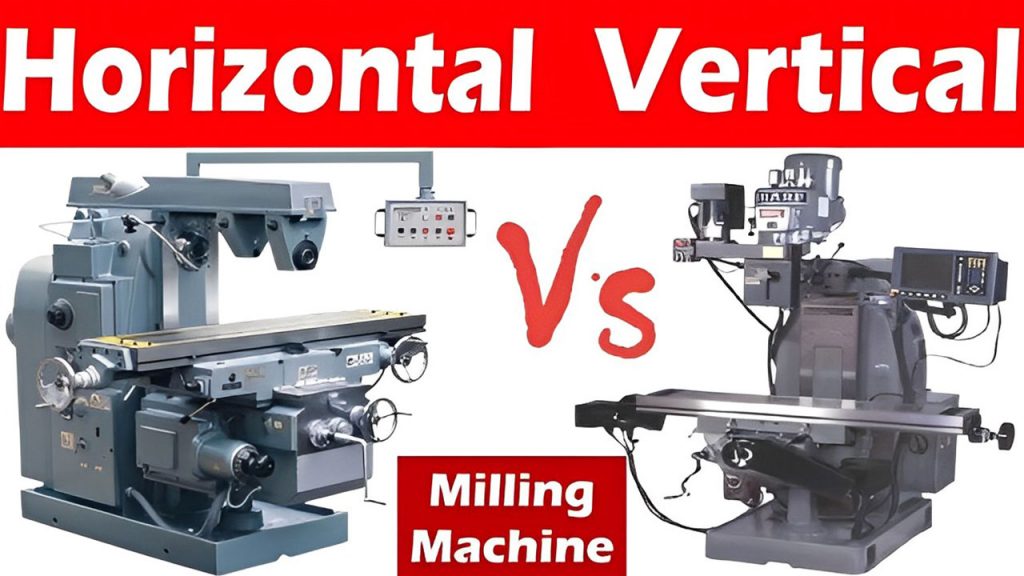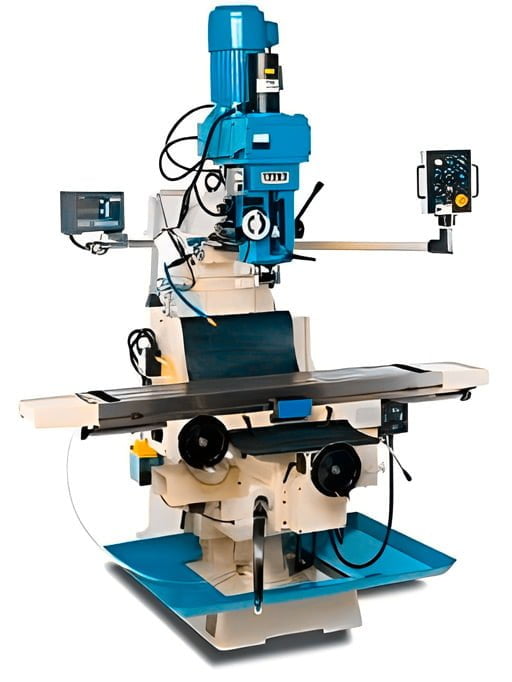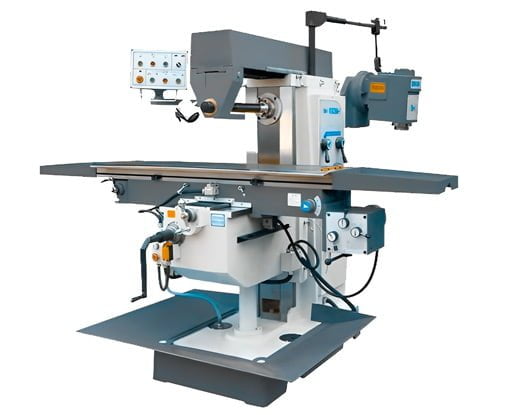In the industrial sector, milling machines are often used to shape hard metal or to manipulate extremely big items. Milling is a common machining method that includes removing material from a stationary workpiece using a rotating cutting tool. They may be horizontal milling or vertical milling, and each has a unique operating characteristic that makes them suitable for certain operations and activities.

This article examines the primary differences between horizontal and vertical milling machines, the uses for each kind, and the advantages and disadvantages of using each. Although all milling machines perform the same fundamental function, some are more suited for particular tasks than others, and their operations vary.
What is Vertical Milling? – Overview

Virtually every machine shop has at least one vertical milling machine. The word suggests that the cutting head, also known as the spindle, is vertically positioned. On some machines, a quill is used with a drawbar to move the R8 spindle vertically along the Z-axis. The drawbar holds the cutting tool needed to make the workpiece while it spins. The worktable may move along the X-axis, the Y-axis, and occasionally the Z-axis, which moves it up and down, depending on the machine.
If the quill is allowed to travel vertically along the Z-axis, the vertical milling machine may perform the functions of a drill press. These machines are suited for single-sided jobs such as sectioning and finishing operations like as beveling. Other examples of comparable employment are as follows. Knee mills, also known as Bridgeport-type milling machines or turret milling machines, and bed milling machines are the two subcategories of vertical milling machines (commonly referred to as bed mills). Each serves a distinct purpose and gives its own benefits.
Each tool available to machinists is optimal for a particular cut and material. As the cutting tool rotates, the milling head enters the workpiece.
Additionally, drills and taps may produce a hole and an internal thread. A wide variety of end mills and cutting tools are available for machining materials ranging from aluminum to titanium.
Vertical milling is further classified into two types, which are as follows:
Ø Turret Milling Machine
The bed of a turret milling machine holds the material in place, preventing the spindle from moving while the machine is in operation. This bed can move both horizontally and vertically, allowing the machine to control the location of the material in either direction. The turret mill is a very versatile piece of machinery, yet, the size of the pieces it produces may often limit its use.
Ø Bed Milling Machine
Bed milling machines feature a spindle that can only revolve vertically, yet the material is transported along the machine’s horizontal axis. The material may be shaped into the desired shape by raising and lowering the spindle. Bed milling machines offer a wide range of motion since the spindle component interacts with the horizontal movement of the bed to permit the milling of a variety of shapes and depths. This kind of milling equipment is sometimes referred to as a horizontal mill.
Benefits of Vertical Milling
· Simplicity:
Vertical milling machines have the benefit of being usually less complicated than horizontal milling machines. Vertical milling machines are thus more cost-effective and easier to use and maintain.
· Versatility:
Due to these variances, there are distinct distinctions between the different kinds of vertical machining centers. Considering movement along two dimensions may be difficult when dealing with larger quantities of material, turret mills are often limited to smaller-scale tasks. On the other hand, bed mills are an excellent option for applications requiring larger and heavier workpieces (yet still far less proficient at processing such items than horizontal mills).
· Footprint:
Vertical milling machines have a substantially smaller footprint than their horizontal counterparts. In addition to the price range, they are ideal for smaller enterprises. Moreover, since they have a more extensive client base, they have access to a larger pool of qualified machinists.
· Cost:
Vertical milling centers are more common than horizontal milling centers, and they are also less expensive, both in terms of the cost of the machine and the cost of maintenance.
· Detail:
Due to their accuracy, vertical milling machines excel in milling microscopic details onto goods with tight tolerances.
Disadvantages of Vertical Milling
VMCs cannot produce in larger quantities or with more complexity. Heavier materials might be a problem for the vertical milling machine’s operations since they can be more challenging to lift and lower.
· Access:
The vertical milling machine excels in single-face millings, such as when sinking dies. However, it is not capable of milling on both sides of a component since it would need a separate work-holding setup.
· Power:
Vertical milling machines, and turret mills, in particular, have trouble processing exceedingly big and heavy components since they need the workpiece to be moved in a continuous motion.
· Speed:
While vertical milling machines have a reputation for precision, they may be much slower than horizontal milling machines when a high output is required.
What Is Horizontal Milling?- Overview

Horizontal milling machines are distinct in a few ways. There have been no significant changes to the underlying processes. Even so, you’ll use a stable workpiece and a rotating tool. But the instrument itself would be held at a horizontal angle.
For larger components or more extensive cuts, milling machines are commonly the tool of choice. Due to the delicate nature of these circumstances, a more objective approach to cutting is required. The tool’s overarm and horizontal rotation provide it with more cutting power and a faster production rate at the sacrifice of precision. Horizontal milling machine centers, however, haven’t had to deal with this issue for a while now, thanks to advancements in CNC technology.
Advantages of Horizontal Milling
· A faster chip evacuation system:
The cutting process creates metal chips, and sometimes those particles melt on the surface, leading to tiny flaws that need to be fixed in post-processing. Horizontal cutters provide a superior finish since the chips are ejected away from the workpiece.
· Better uniformity:
The cutting tool used by horizontal machines is thicker and shorter than that used by vertical machines, making them more suited for deep-cutting operations. Therefore, there will be fewer vibrations and more steadiness as a consequence.
· Being able to manipulate intricate forms
Horizontal mills can accommodate a wide range of angles and various accessories to facilitate the production of intricate shapes. Unfortunately, this cannot be accomplished using a vertical milling system due to technical constraints.
· Improved Performance:
Having a greater rate of material removal, improved chip evacuation, and the ability to achieve deeper cuts in one pass allows you to accomplish more in less time while maintaining exceptional productivity.
Disadvantages of Horizontal Milling
· Expensive:
Horizontal milling equipment is more expensive to buy and maintain than vertical machines. This is why they are peculiar to high-volume industrial situations. CNC machining services are a more cost-effective solution for small businesses since they do not need a large financial commitment.
· Trained employees are harder to get by:
The major disadvantages of employing a horizontal milling machine are the high cost of purchase and maintenance, as well as the difficulty in acquiring appropriately experienced operators. This is because of a simple explanation. Due to the rarity of these gadgets, only a few people have firsthand knowledge of how they work.
Comparing Vertical Milling and Horizontal Milling
· Orientation
As far as the differences between the two layouts go, this is likely the most important. The orientation of the spindle determines how the cutter contacts the workpiece. As the names of the two machine types imply, vertical machining delivers higher precision, while horizontal machining provides greater depth.
· Geometry of Tools
Another difference is the geometry of the implement. A vertical milling machine’s milling cutter is thin and cylindrical. On the other hand, horizontal machines have shorter and thicker tools that allow them to make more significant cuts and handle larger pieces of work.
· Cutting Accuracy
The enhanced accuracy of the vertical tool is worth the trade-offs for delicate tasks. A vertical tool cannot accomplish deeper cuts due to vibration and consequent design adjustments. Vertical tools are longer and thinner than horizontal ones but are more flexible and can produce shallower cuts against resistance.
· Material Removal Plate
Horizontal milling machines surpass vertical milling machines in terms of removal rate due to their greater stability and ability to make deeper cuts. Vertical machines are often employed for certain operations, such as facing and grooving, where the cuts do not need to be extremely deep, and accuracy is critical.
Conclusion
In the last two decades, milling machines have seen substantial development. In addition to the various manufacturing benefits they provide, they facilitate the fabrication of machine components.
Modern vertical and horizontal milling techniques complement each other well, and it is crucial to grasp their distinctions to make an informed choice. I hope the information above will put you in a better position to accomplish the same outcomes.
| Turning Method | Milling Method |
| Internal Turning & External Turning Taper Turning | Shoulder Milling Side Milling Face Milling Ramp Milling Plunge Milling Peripheral Milling Helical Milling Groove Milling Vertical Milling & Horizontal Milling Conventional Milling & Climb Milling |











2 Responses
very good nice blog page thank you
I appreciate you sharing this blog post. Thanks Again. Cool.